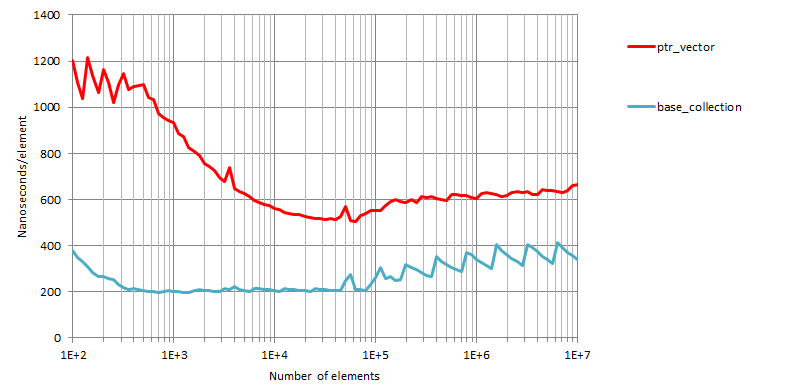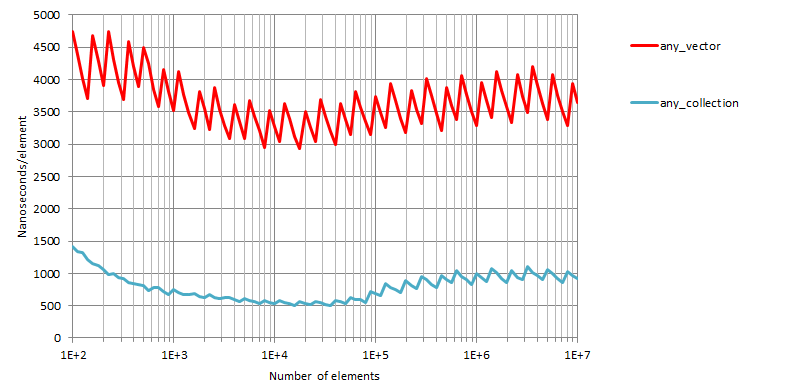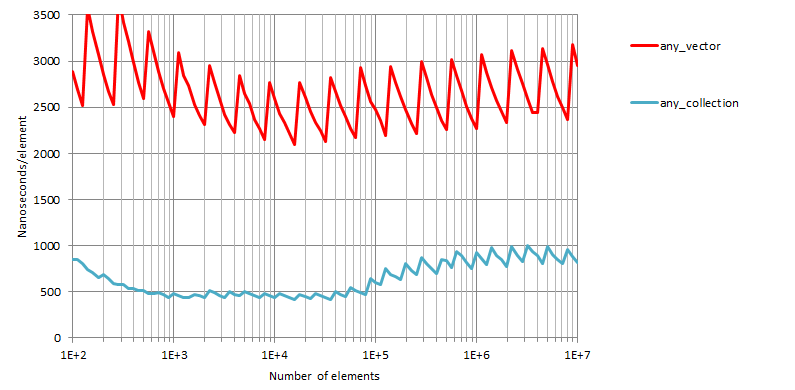We ran tests to measure the performance of the containers of Boost.PolyCollection
in two scenarios:
As a comparison baseline we used containers and facilities from the standard
library and Boost (details below). Tests were run on a Windows 10 machine with
8GB RAM and an Intel Core i5-8265U CPU @1.60GHz (base frequency) for the following
environments:
-
Baseline container:
ptr_vector
= boost::ptr_vector<base>
-
Polymorphic collection:
base_collection
= boost::base_collection<base>
-
Element types:
T1 =
derived1, T2 = derived2,
T3 = derived3
struct base
{
virtual ~base()=default;
virtual int operator()(int)const=0;
};
struct derived1 final:base
{
derived1(int n):n{n}{}
virtual int operator()(int)const{return n;}
int n;
};
struct derived2 final:base
{
derived2(int n):n{n}{}
virtual int operator()(int x)const{return x*n;}
int unused,n;
};
struct derived3 final:base
{
derived3(int n):n{n}{}
virtual int operator()(int x)const{return x*x*n;}
int unused,n;
};
-
Baseline container:
func_vector
= std::vector<std::function<int(int)>>
-
Polymorphic collection:
function_collection
= boost::function_collection<int(int)>
-
Element types:
T1 =
concrete1, T2 = concrete2,
T3 = concrete3
struct concrete1
{
concrete1(int n):n{n}{}
int operator()(int)const{return n;}
int n;
};
struct concrete2
{
concrete2(int n):n{n}{}
int operator()(int x)const{return x*n;}
int unused,n;
};
struct concrete3
{
concrete3(int n):n{n}{}
int operator()(int x)const{return x*x*n;}
int unused,n;
};
-
Baseline container:
any_vector
= std::vector<boost::type_erasure::any<concept_>>
-
Polymorphic collection:
any_collection
= boost::any_collection<concept_>
-
Element types:
T1 =
int, T2
= double, T3 = char
using concept_=boost::mpl::vector<
boost::type_erasure::copy_constructible<>,
boost::type_erasure::relaxed,
boost::type_erasure::typeid_<>,
boost::type_erasure::incrementable<>
>;
-
Baseline container:
variant_vector
= std::vector<std::variant<int,double,char>>
-
Polymorphic collection:
variant_collection
= boost::variant_collection<boost::mp11::mp_list<int,double,char>>
-
Element types:
T1 =
int, T2
= double, T3 = char
Tests measure the time taken to traverse a container of size n
(n between 102 and 107) and execute an operation on each
of its elements. The operation for boost::base_collection
and boost::function_collection (and the associated
baseline containers) is defined as
struct for_each_callable
{
for_each_callable():res{0}{}
template<typename T>
void operator()(T& x){
res+=x(2);
}
int res;
};
whereas for boost::any_collection we use
struct for_each_incrementable
{
for_each_incrementable():res{0}{}
template<typename T>
void operator()(T& x){
++x;
++res;
}
int res;
};
and for boost::variant_collection we have
struct for_each_alternative
{
for_each_alternative():res{0}{}
template<template<typename...> class V,typename... Ts>
void operator()(V<Ts...>& x){
visit(*this,x);
}
template<typename T>
void operator()(T& x){
++x;
++res;
}
int res;
};
The baseline container is tested with three different setups:
-
Directly as initialized by the process described for the insertion
tests. As elements are ordered according to their construction
time, certain degree of memory contiguity is expected.
-
With an extra post-insertion stage by which elements are sorted according
to their type. This increases branch prediction efficiency at the expense
of having worse cache friendliness.
-
With an extra post-insertion stage that randomly shuffles all the elements
in the container. This is the worst possible scenario both in terms of
caching and branch prediction. We don't exercise this setup for
variant_vector as it is at equivalent
to the direct case (std::variant
does not allocate dynamic memory).
As for the polymorphic collection, three variations are measured:
-
With
std::for_each (the same as the baseline
container).
-
Using
boost::poly_collection::for_each.
-
Using
boost::poly_collection::for_each with type
restitution of T1,
T2 and T3.
The figures show resulting times in nanoseconds/element. The horizontal axis
is logarithmic.
 Processing, Visual Studio
2022 x64
Processing, Visual Studio
2022 x64
 Processing, GCC 13.2
x64
Processing, GCC 13.2
x64
 Processing, Clang 13.0
x64
Processing, Clang 13.0
x64
 Processing, Visual Studio
2022 x64
Processing, Visual Studio
2022 x64
 Processing, GCC 13.2
x64
Processing, GCC 13.2
x64
 Processing, Clang 13.0
x64
Processing, Clang 13.0
x64
 Processing, Visual Studio
2022 x64
Processing, Visual Studio
2022 x64
 Processing, GCC 13.2
x64
Processing, GCC 13.2
x64
 Processing, Clang 13.0
x64
Processing, Clang 13.0
x64
 Processing, Visual Studio
2022 x64
Processing, Visual Studio
2022 x64
 Processing, GCC 13.2
x64
Processing, GCC 13.2
x64
 Processing, Clang 13.0
x64
Processing, Clang 13.0
x64
 Boost
C++ Libraries
Boost
C++ Libraries



























